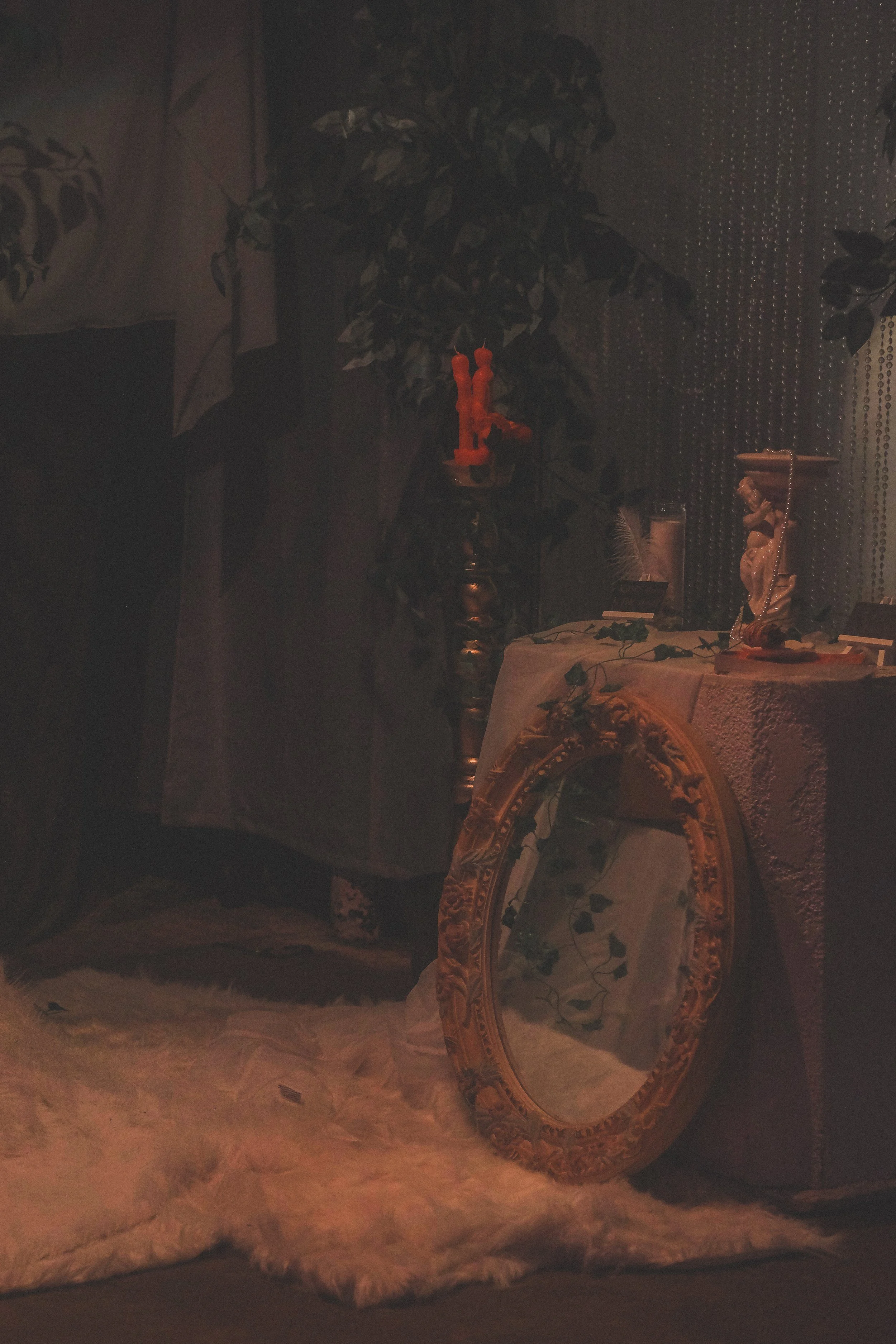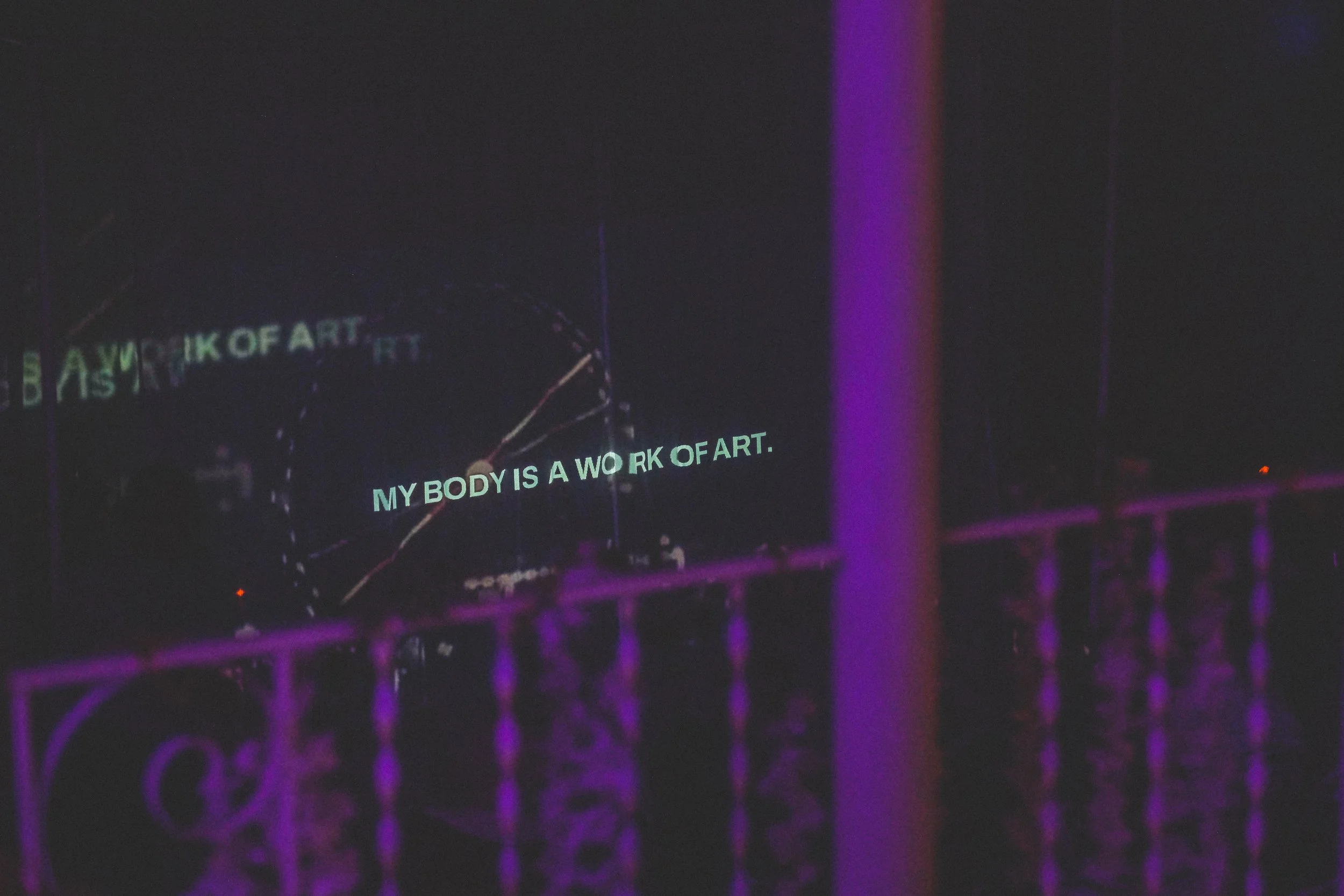Photo Courtesy of Tyquan D. Morton
Written by: Oliver Heffron
Tyquan D. Morton’s The Sacral Project is a collaborative multimedia exploration of sexuality, eroticism, and intimacy. The project emphasized the Sacral Chakra, the 2nd primary chakra in the Hindu religion associated with sensuality, sexuality, and creativity, through an engagement of all five senses.
Hosted at the cë gallery in Nashville, a venue that combines the expanse of a warehouse with the subtlety of a secret speakeasy, Morton curated a space that would centralize The Sacral Chakra and create a safe, open environment to explore the empowering, creative, and collaborative aspects of eroticism and sexuality. The space featured vendors with items related to the chakra, books covering relevant ideas, food from a local vegan spot Vlimax, and a DJ performing for cocktail hour before the main screening, featuring a diverse collection of short films by brown and black creators and stitched together by curator Tyquan D. Morton.
The screening began with a sound bowl designed especially for the Sacral chakra that turns the audience towards The Sacral Cube. Built with PVC pipes and covered in mesh curtains, The Sacral Cube captured the projections of short films and live poetry performances assisted by visuals, where the poets performed from inside the square. The audience was invited to get comfortable on chairs or sit closer to the center on a soft carpet.
The Sacral Project’s creator and curator, Tyquan D. Morton, sat down with Nuance to discuss his inspiration and vision for the project.
Photo Credit: Hare.
Tyquan D. Morton’s first love is poetry. Since self-publishing a book of poetry, Remembering Pluto, in 2018, Tyquan D. Morton explains that his years of teaching, going through the pandemic, and moving to Nashville for Grad School at Peabody College created a need for him to express himself again poetically: “A lot of it was stored up creative energy that I wasn’t able to really put out since 2018 when I published my book.” Morton remembers a specific poetry reading in Nashville about a year ago as the primary catalyst for The Sacral Project’s exploration of sensuality:
“I went to the spot in Nashville. It’s a coffee lounge that sells a lot of bourbon and coffee drinks, it’s really swanky with a piano in there, kind of gives it a jazz, European vibe. So, I walk in and the host of the open mind essentially just told me, ‘we have kids here, so we just ask for you and for for everyone to not to read anything that was sensual, sexual or political.’”
Having just gone through a breakup and the COVID pandemic, Morton’s poetry was exploring sexuality and sensuality at the time, and he realized the vast disconnect between how his work was helping him better understand himself and how the world contextualized sex into something not acceptable for a poetry reading:
“I was writing a lot of very sensual pieces, and not in the sense of like, ‘People are fucking. People are about doing this, people are doing that,’ but more so in the sense of like, ‘Okay, this is just to get in touch with myself a bit more. This is really about how I share my body with other people.’
So going into that open mic, having been writing all these poems for the past few years, and having someone say that, I really started to think about, okay, what are people’s understandings of what sexuality and intimacy is? And what are people’s understanding of erotic energy as well? Because I think everyone’s understanding is very, very different. I really think about being able to embrace your sexual side and being able to embrace your intimate side, especially when you choose to without restraint, is in itself a very political thing.”
After graduating from Grad School at Vanderbilt, Morton wanted to organize an event that situates poetry and poets within a light of high performance more akin to a musician in a music video instead of the cold open-mic readings that usually exhibit their craft. After initially conceptualizing The Sacral Project as a series of personal short films, the more he ruminated on the concept of sensuality, the more he realized he needed more perspectives outside of himself, and thus set out to curate a space to exhibit not just himself but a series of poets, filmmakers, and artists who could elaborate their vision of the sacral chakra:
Photo Credit: Hare.
“I only have one side of that. I’m black, I’m gay, I’m from the south, I have all of these different identifiers, but that’s only going to paint one side of the picture of what sexuality, what intimacy is for folks. So, I was very intentional about the people that I got involved with. I wanted people that were along the sexuality spectrum. I wanted women, I wanted men, I wanted trans folks, but I think the thing I was most specific about is it being as black and brown as possible.”
Reaching out to poets, filmmakers and artists he’s met or heard about over the years, Morton put together an impressive roster of creators to collaborate on the project. Morton explains that race was essential to the project since black and brown people are culturally oversexualized: “I think it was important for me because it’s, I think, oftentimes a lot of spaces, black and brown folks, whether they’re men or women, whether or not there’s any other layer as far as identification, oftentimes it’s hyper-sexualized. Oftentimes, it’s understood when black and brown thoughts are being sexual, I found it’s seen as lesser than.”
Morton explains how he knew the details would be essential to create the necessary environment:
“We really want them to be in the space of sensuality. Something as small as like, ‘hey, we have this citrus hand soap, and so when you wash your hand it’s gonna linger on even afterward, and during the event we have incense that is related to the sacral chakra. Because it’s so sensual, aside from the sexual aspects, we really wanted to touch on all those five senses just to make it as immersive as possible.”
Photo Credit: Hare.
When looking for collaborations to help bring the project to fruition, Morton turned to the artists and creative people in places he’s lived over the past few years: “I started with a lot of my colleagues from like the city that I live in, I think, in my mind like that was first nature, to start with people that understood my vision and it’s gonna be the highest of quality.”
The Sacral Project features creators from a variety of perspectives and forms: spoken word poetry from Nashville natives Simba Alik and Wisdom Wright; exhibitions from local artists Elizabeth Zerihun, Alexis Wolfe, and Joseph Patrick; and a variety of short films. Nashville native Eugene Johnson’s “Intermitten Internal” artistically slices together clips of self-facing contemplates the effects of emotional vs. physical intimacy, expressing the internal stress of dealing with these emotions with an avoidant attachment style. Rachel Ebio, also a local, narrates visceral descriptions of physical expression while superimposed images of rich green, natural worlds and massaging hands create a calming atmosphere on “Untitled Letter No. 1” Angelica Gutierrez, Jenny Gutierrez, and Marina Goitia’s “The Sacral Short” see the three narrate intimate monologues about the meaning of feminine eroticism and sensuality in Spanish and English while performing interpretive dances on a bed of projections.
Philadelphia’s Vernon Jordan III aligns visuals of his morning routine with a poetic internal dialogue about the inspiring power of shared intimacy. Joseph Patrick’s “NOWORDS” portray a subject enjoying a VR sexual experience, pairing dissonant piano keys that contemplate the uncanny reality of digital intimacy. St. Paul-native Lester Mayers delivers medicine against the silent killer, shame, in the medium of a love hotline on “Love Lesson.” Additionally, there were short films from The Auntie House Podcast (Ebonique Brooks and Joy Liburd) from Jacksonville, FL, and Charleston native and old friend Asiah Mae Thomas.
Photo Credit: Hare.
In addition to preparing his own poetry reading and designing the space, Morton’s role within the screening was to weave together all these different perspectives into one story. Inspired by the editing style of Terence Nance’s Random Acts Of Flyness, Morton utilized archival footage, pop culture references, and emerging technologies like AI-generated images and motion graphics created by Dalle-2 to stitch the different pieces into a broader narrative. The product is an impressive, immersive film-length visual and audio orchestration that highlights each perspective’s voice while creating a more profound meaning through its complete sequence.
When all put together, The Sacral Project creates a space for sexuality, sensuality, and eroticism to be understood in a new, empowering light. Through the artistic expression of black and brown creators, those whose eroticism has been most culturally misrepresented, Morton’s project subverts the usual taboo depiction of sexuality within a restorative atmosphere:
“It’s just figuring out these ways to make this more informative, to make it humorous, and literally portray this entire vast range of emotion, just so to get back to their selves, and honestly come out with the experience understanding sexuality and intimacy in a very safe way.”





